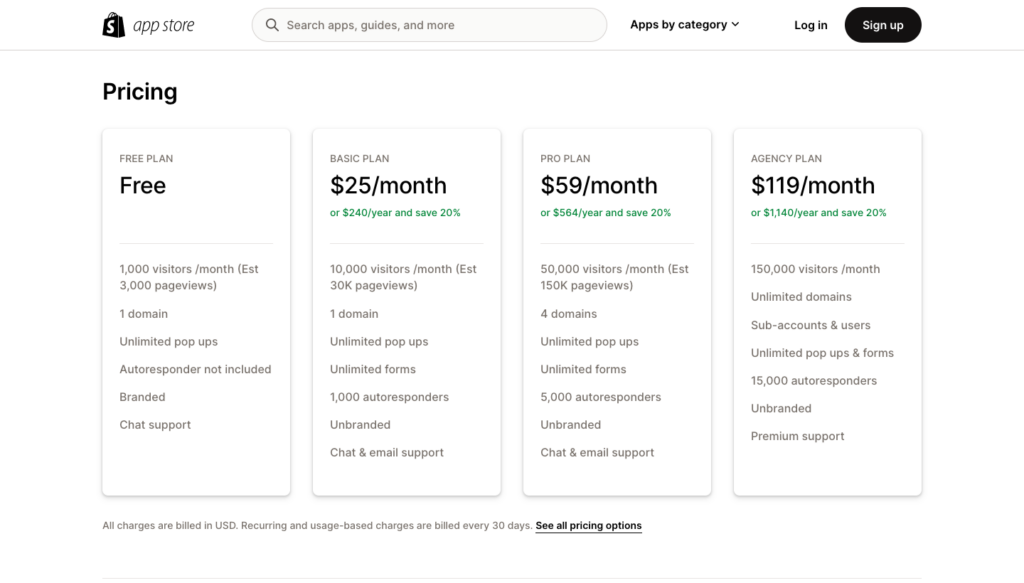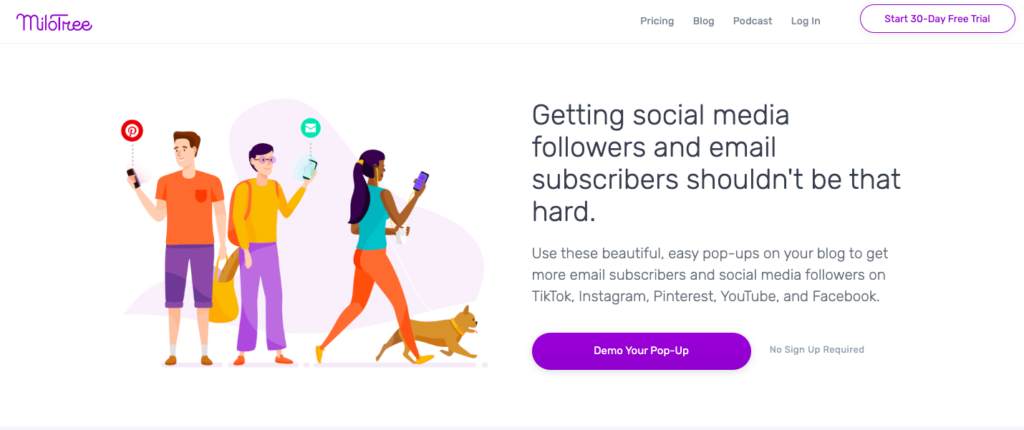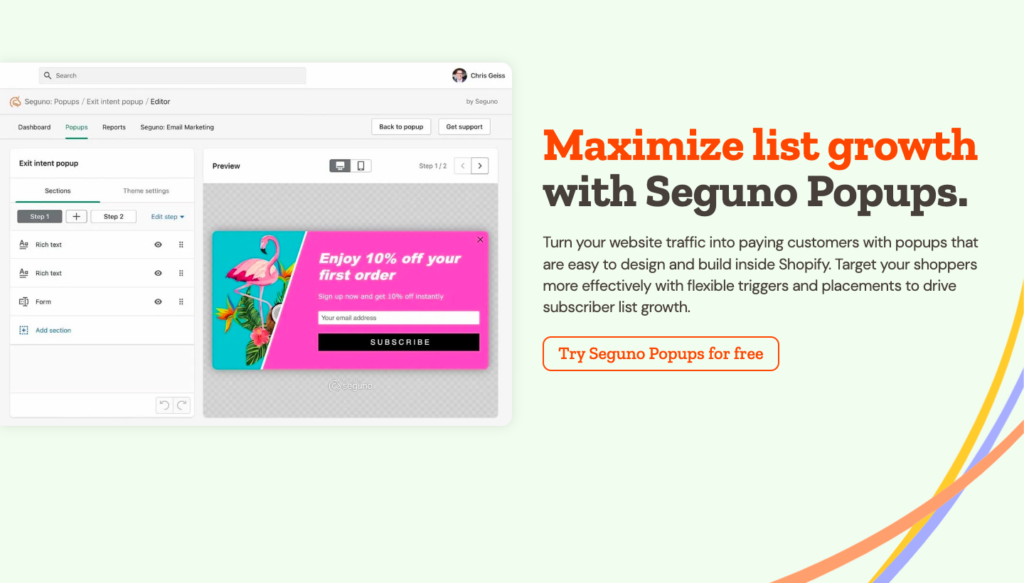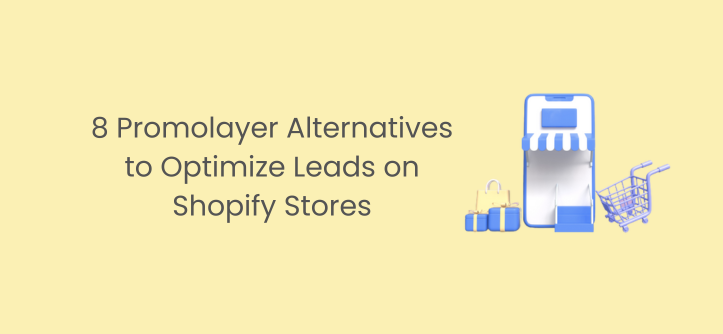Shopify stores can be incredibly lucrative when leveraged right. Of course, getting potential customers to convert is half the battle you will face. One of the more proven strategies is the use of popups.
In this sense, it doesn’t mean the typical adware that will turn customers off. It means simple windows that are not too jarring and can influence people to take whatever action you want. Both your lead generation and your conversions can benefit when you pull this off right on your Shopify website.
The first step is ensuring that you have the right popup builder in your corner.
Promolayer is a platform that site owners use in this way to improve sales. You can get up and running fairly quickly with high-converting popups. Some of the notable benefits are:
- Back button capture and exit intent popups
- Segmentation tools and triggers
- A wide range of templates to choose from
- Responsive popups that don’t need to be adjusted for mobile displays.
It can be a great conversion rate optimization tool, but unfortunately, it’s limited by the glitches and bugs that sometimes pop up. While the customer service team is responsive, these issues still exist and can detract from the full experience.
Thankfully, there are outstanding Promolayer alternatives that you can consider, which are covered below.
How Popups Can Optimize Leads on Shopify Stores
The biggest challenge that many e-commerce stores will face with their potential clients is cart abandonment. It’s not uncommon for people to fill up a cart and then navigate away just when they needed to checkout.
What you want to do is use popups to alleviate this problem. Of course, you can’t just use any popup and hope that it will work. There are right and wrong popups for different situations, just as there are right and wrong timings.
For example, there are exit-intent popups that you’ll want to use when someone is either on the checkout or cart page. Once they have items in the cart and start to navigate away from the page, you could have your popup appear. The idea would be to entice the customer with something to close the deal. This could be a discount, coupons, etc.
On the other hand, there are cross-sale and up-sale popups that are meant to secure more business from existing customers. Even if you’re using contact forms or subscribe forms here just to gather information to then reach out to upsell, timing and relevance matter. You can’t see someone searching for shoes and then you’re trying to sell a blender.
The optimization element of the equation comes from getting the right popup to achieve the right effect. Doing it right requires good timing, a clear call to action, an option to decline, easy-to-read text, relevant images, etc.
What Promolayer Alternatives Should You Consider?
As indicated before, Promolayer is one option that you could consider. However, while the core experience is good, the bugs can take away from things. Be that as it may, you still need a platform that helps you to use popups to drive engagement.
Thankfully, you’re in the right place! Below, you’ll get a rundown of some of the best Promolayer alternatives on the market.
1. Poptin
Poptin is the definitive Promolayer alternative if you’re hoping to make your popups as engaging as possible as you attempt to convert as many visitors as possible into potential customers.
Thanks to the straightforward user interface and extensive customization, you can have beautiful popups ready for use in no time. Speaking of time, with Poptin, it’s that much easier to ensure that the right popup is shown to the right customers at the right time, thanks to smart popups.
Other key features include embedded forms that allow you to collect high-quality leads organically. You can then take advantage of integrations to leverage them.
There’s even an autoresponder you can use to welcome new subscribers or let them have a coupon code.
The pricing model is easy to follow as you can select any of the following:

- Free tier – Free
- Basic tier – $25/mo
- Pro tier (most popular) – $59/mo
- Agency tier – $199/mo
You can save on all the paid tiers by going for annual billing instead. Have a look at the pricing page to get a rundown of what each plan offers.
Pros
- Straightforward
- Over 40 customizable templates
- Well-designed pricing plans to accommodate different needs
- Several customer support channels with great support
Cons
- Plans with more features are pricey
2. Privy
If the goal is to grow e-mail and SMS contacts, then privy is a good way to go. The popup options are meant to be easily created and used, which means you get to focus more on growing your business.
Pricing ranges from $30/mo to $70/mo across three plans. There is a free option, but it’s only a 15-day trial.
Pros
- Email and SMS automations that work 24/7
- Easy onboarding process
- Drag and drop editor with built-in templates
Cons
- No permanently free plan
3. MiloTree

MiloTree is an option if you’re looking to grab more email subscribers and followers on social media. Beyond the popup side of things, it features content management elements that can help you keep your site engaging.
There’s no free plan here, but there is a free 30-day trial. Beyond that, there’s the “Awesome” plan and the “Smart & Awesome” plan for $9/mo and $99/yr respectively. Apart from that, you can reach out for a custom solution.
Pros
- Easy popup management
- Multi-level account management
- Great customer service
Cons
- No free forever plan
- A custom solution is needed for any customer that can’t use the existing plans
4. Rivo Email Popups
Regardless of how big or small your Shopify store is, Rivo Email Popups is the perfect tool to help you drive conversions and sales in a short time, which is especially great for those who don’t know how to code.
There are no separate pricing plans since it’s free. Of course, that means that you have to deal with some level of limitations.
Pros
- One-click installation process
- Free
- Round-the-clock support
Cons
- No tag options
- Filters and customization is limited
- No automatic email to new subscribers
5. PopConvert
This is a spin on the popup formula. Instead of the typical text and media elements, there’s gamification used here. The intention is the same though, aiming to provide better lead conversions for bloggers, e-commerce businesses, and marketing agencies.
Site owners can easily invite visitors to play a game, gathering marketing opt-ins using a series of personalized widgets.
As far as pricing goes, you can get either 7 days or 80 conversions free, depending on which comes first. The actual plans are for $49/mo, $69/mo, and $100/mo for the basic, start up, and pop subscriptions, respectively.
Pros
- Unique gamification approach
- Great campaign management
- Straightforward
Cons
- No permanent free plan
- Not appealing to visitors who are turned off by games
6. POWR Popup
POWR Popup is another option that allows you to maximize profit, increase conversion rates, set up special sales campaigns, and even promote discounts and coupon codes.
You can use the built-in templates to adjust to your strategy, even if it’s seasonal. Apart from motivating your customers to purchase, you can also use POWR Popup to set up auto-responder emails, collect contact information, and more.
The pricing starts with a free tier. There is also a starter and pro tier for $5.49/mo and $13.49/mo, respectively. A business tier is also available, which is a huge step forward in cost standing at $89.99/mo. All these plans can also be bought annually for 10% savings.
Pros
- Great integrations
- Nice customizability
- Support for multiple languages
Cons
- Can be glitchy
- Customizations are not enough for the prices
7. Sales Pop-up Conversion Pro
A big Shopify store strategy is to prey on FOMO, and Sales Pop-Up is all about that. The features available help you to create a sense of urgency while making it very easy to get to buying pages. Apart from this somewhat anxiety in inducing timers and countdowns, there are also trust badges and social proof that you can use to make new shoppers more comfortable.
There is a permanent free plan available and a pro version that costs $4.99/mo. If you want, you can also get a 14-day free trial of the paid subscription.
Pros
- Great for FOMO tactics
- Round-the-clock support
- Unlimited impressions
Cons
- The feature set is pretty limited
8. Seguno

Seguno is another pretty easy pop-up option that you can consider. Whether it’s announcements, guiding visitors to specific pages, promoting unique propositions, are just growing your subscriber list, it can assist you. In fact, you can have your popups feature multiple steps to achieve different goals.
There is a free tier, as well as two paid tiers, which both cost $10/mo. The first is usage-based for any Shopify merchant. Secondly, there is an unlimited version, offered to people who are already customers of Seguno’s e-mail marketing offering. A 10-day free trial of both paid plans is available.
Pros
- Straightforward
- Multi-objective popups
- Built for Shopify
Cons
- Limited feature set
- Support only available via live chat
Final Thoughts
Shopify stores can benefit greatly from popups that drive purchases, Collect subscriber contact info, handle exit intent, and more.
While Promolayer is well-designed, it can be limited by optimization and glitch issues. Poptin is an incredible alternative, featuring deep customization, a straightforward user experience, different pricing options to meet different needs and great support.




